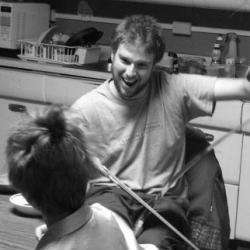Sō Percussion finished their four-day run of Where (we) Live on Saturday 22 December. A resplendent and confusing bonanza, the hour-long concert consisted of poignantly thin and simple melodies, intensely personal testimonial, performative carpentry, and absurdist and stop-motion film, all piled together with a demeanor of contemporary improvisation and glam rock dressed in flannel. The goal seemed to be making the audience’s experience as immediate as possible, so surprising and real that the dust and pathos stuck in your hair for hours after.
The performance began with an invitation to meditate on the place you call or called home, a direct and unvarnished human appeal to the audience to connect with the musicians (you can see parts of this on the trailer for the show on Sō’s website). The array of drum kits, toy piano, glockenspiel, vibraphone, grand piano, small instruments, and side drums occasionally came together for grooving sections that were surprisingly effective in providing support for the sung segments. The effect of four percussionists playing a unison tattoo was powerfully done and, all things considered, less like Tool than it could have been.
The sequence of events was set ahead of time, which after seeing the performance is somewhat surprising. The performers certainly had an assured air that made me think it had been rehearsed, but most of the content of the show seemed designed to cancel out that impression. They describe this process as including theatrical and aleatoric components in a “society of possibilities”, and the effect was a feeling of authenticity that depended on the off-the-cuff presentation. This was considerably reinforced by the presence of a note-taker whose sole job was to provide apparently spontaneous instructions to the performers.
The visual element, in many manifestations, was primary throughout the concert. The scene of action seemed to be self-consciously utilitarian, with several percussion tables cluttered with not only the instruments themselves, but also various microphones, lamplights, sound cables, and video cameras. Those live cameras captured some of the performers’ action and projected it, along with a substantial amount of prepared video, onto five makeshift screens scattered throughout the performance space. The woodworker’s tools occasionally sent billows of sawdust into the air above the performance space, and at one point the music consisted almost entirely of performers’ individual lights switching on and off to a synchronizing ticking pulse.
At points, this visual emphasis detracted somewhat from the musical experience. Whether this was intentional or not, the effect of the filmed and projected performers wound up seeming at least a little sarcastic. Especially in response to the image of Emily Johnson paying rapt attention and getting up to provide feedback, I felt that my own experience as a listener was getting appropriated by the performers. I was not able to inhabit my own listening body without feeling commented upon. All of which might very well have been part of the goal of the visual component as an active engagement with the audience; overall, however, it wound up being a distraction from the musical moments rather than an interesting addition or counterpoint.
This listener walked out with the thought that, right or wrong, the way most of an audience decides if a performance is good is whether they have seen someone do something that they could not do. This means the performer is typically expected not only to be better at something, but better in a way that less-skilled people can recognize. The Kickstarted™ origins of Where (we) Live invites us to hear the concert as an attempt to bring people in, to engage them with the music in new ways. The final tune was an a cappella “thank you” with the sincere syntactical grit of Woody Guthrie’s lyrics, and it was for everyone who had already engaged in an even deeper way than the audience present in the theater that night.
The core performers of Sō Percussion are Eric Beach, Josh Quillen, Adam Sliwinski and Jason Treuting. Grey McMurray joined them on guitar and vocals, M.C. Schmidt made the film sequences, Emily Johnson listened intently and gave written notes to performers, and Victoria Valencia hand-planed and circular-sawed a large piece of wood. Valencia was one of a rotating cast of artisans/artists that changed throughout the run and included a blacksmith, a painter, and a ceramicist.


